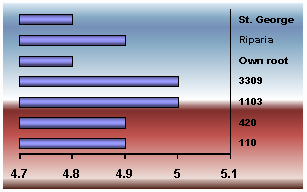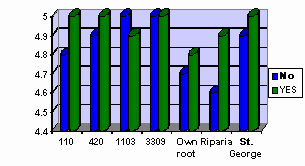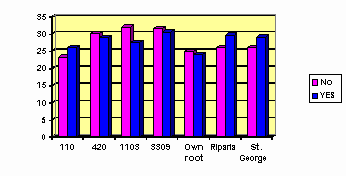Preliminary results of rootstock study
Although most vineyard plantings in the Midwest are of vines on their own roots, grafting the desired cultivar onto rootstocks is a standard practice in most European and California vineyards and in many other parts of the world. The rootstock imparts resistance to certain pests, notably phylloxera and nematodes, and may help with adaptability to soil and other environmental conditions. This study is part of Mr. Sanjun Gu's Ph.D. research and involves the scion cultivar "Gewurztarminer" grafted onto several different rootstocks and on its own roots for comparison. "Gewurztarminer" is considered marginal at best for Nebraska conditions, but it is hoped that this study will yield information that helps with our understanding of environmental adaptability. Rootstocks employed include:
- Riparia 'Gloire' (Vitis riparia)
- St. George (V. Rupestris)
- 3309 Couderc (V. Riparia x V. rupestris)
- 110 Richter (V. Riparia x V. rupestris)
- 1103 Paulsen (V. Berlandieri x V. riparia)
- MG420A (V. Berlandieri x V. riparia)
Data were taken in May, 2000.
This study was established in May, 1999 and is repeated in two other Nebraska locations.
Preliminary results of rootstock study
Nemaha
No obvious differences could be observed from 6 rootstocks and the own rooted material, probably because of the relatively mild weather last winter.
| Variety | Survival rate | Length of the longest shoot | Number of shoots | Leaf area (length x width) | Height |
|---|---|---|---|---|---|
| 110R | 4.9 | 12.5 | 24.6 | 7.7 | 22.5 |
| 420A | 4.9 | 13.7 | 30.2 | 7.3 | 26.7 |
| 1103P | 5.0 | 14.9 | 29.8 | 7.0 | 25.8 |
| 3309P | 5.0 | 12.3 | 31.0 | 7.4 | 20.9 |
| Riparia | 4.8 | 11.8 | 27.9 | 7.0 | 22.7 |
| St. George | 4.9 | 11.0 | 27.5 | 6.6 | 25.0 |
| Own root | 4.8 | 13.3 | 24.5 | 7.7 | 22.3 |
Note: survival rate (0, dead; 1, with 1~3 buds; 2, 4~6 buds; 3, 7~9 buds; 4, 10~15 buds; 5, 316 buds ); length of the longest shoot and height are in inches; leaf area is in square inches.
Winter Damage
Experiencing a relatively mild winter in 1999, all materials tested survived well. Only a very few of them died and most of the dead were caused by rabbits.

Influences of mounding
In order to protect the plants from winter damage, half of them were mounded in late Fall, 1999. Differences were found on all the items investigated though different rootstock species responded differently.
Note: YES denotes mounded; NO, not mounded.

